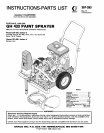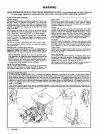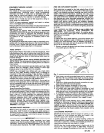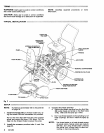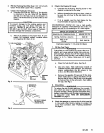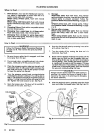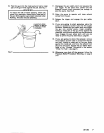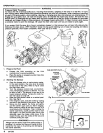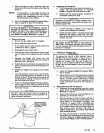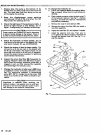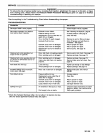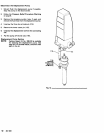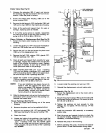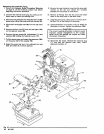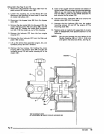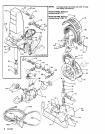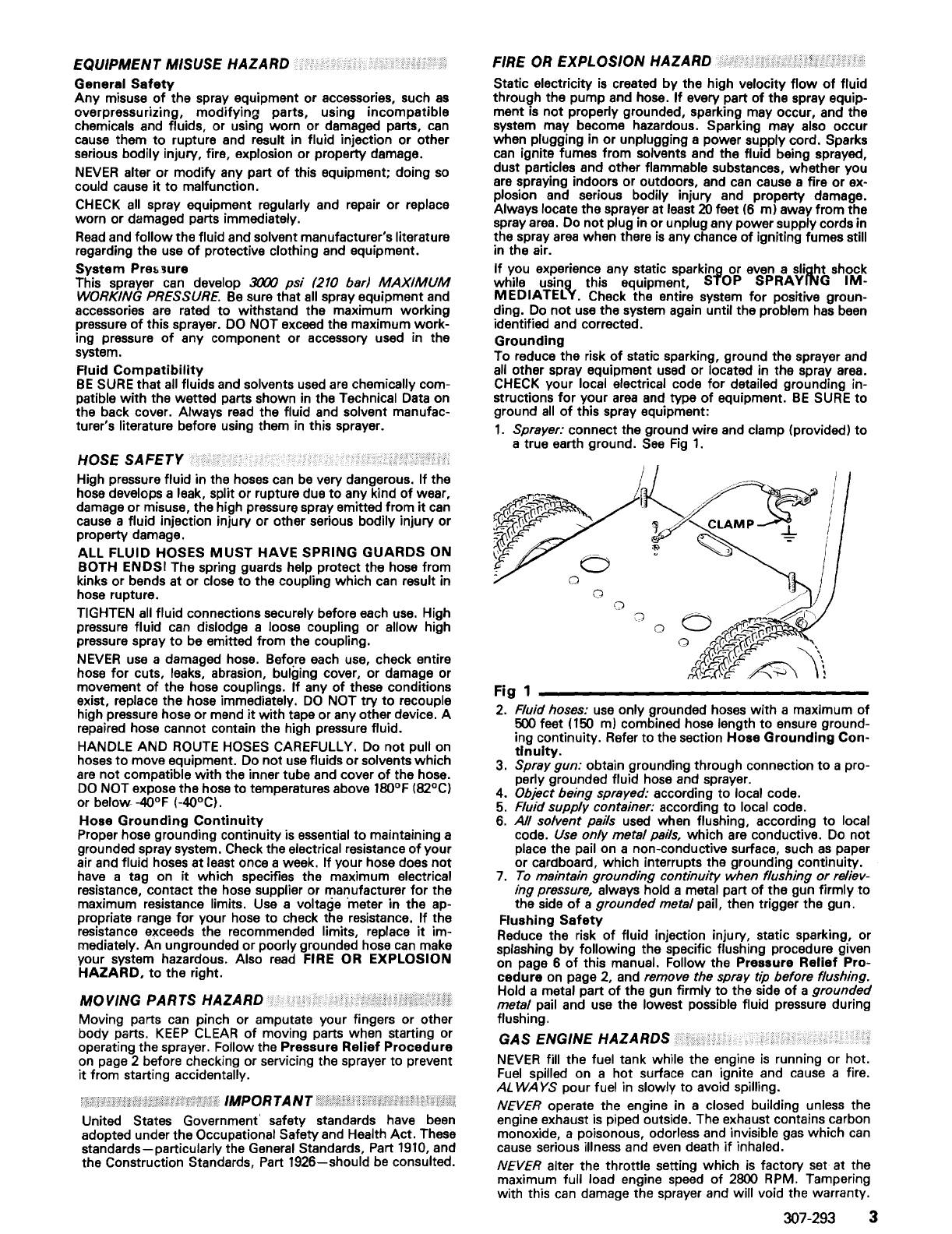
EQUIPMENT MISUSE
HAZARD
General
Safety
Any
misuse
of
the spray equipment or accessories, such
as
overpressurizing, modifying parts, using incompatible
chemicals and fluids, or using worn or damaged parts,
can
cause
them
to
rupture and result in fluid injection or other
serious bodily injury,
fire, explosion or property damage.
NEVER
alter
or
modify any part
of
this equipment; doing
so
could cause
it
to
malfunction.
CHECK
all
spray equipment regularly and repair
or
replace
worn or damaged parts immediately.
Read
and follow the fluid and solvent manufacturer's literature
regarding the use
of
protective clothing and equipment.
System
Preb Jure
This sprayer
can
develop 3000
psi
(210 bar)
MAXIMUM
WORKING
PRESSURE.
Be
sure that
all
spray equipment and
accessories
are
rated
to
withstand the maximum working
pressure
of
this sprayer.
DO
NOT exceed the maximum work-
ing pressure
of
any component or accessory used
in
the
system.
Fluid
Compatibility
BE
SURE
that all fluids and solvents
used
are
chemically com-
patible with the wetted parts shown
in
the Technical Data on
the back cover. Always
read
the fluid and solvent manufac-
turer's literature before using them
in
this sprayer.
HOSE
SAFETY
High pressure fluid in the hoses
can
be
very dangerous. If the
hose develops a
leak, split or rupture due
to
any kind
of
wear,
damage or misuse, the high pressure spray emitted from
it
can
cause a fluid injection injury or other serious bodily injury or
property damage.
ALL
FLUID HOSES
MUST
HAVE
SPRING
GUARDS
ON
BOTH ENDSI
The spring guards help protect the hose from
kinks or bends at or close
to
the coupling which
can
result in
hose rupture.
TIGHTEN
all
fluid connections securely before
each
use. High
pressure fluid can dislodge a loose coupling or
allow high
pressure spray
to
be emitted from the coupling.
NEVER
use a damaged hose.
Befo.re
each use, check entire
hose
for
cuts, leaks, abrasion, bulging cover, or damage or
movement
of
the hose couplings.
If
any
of
these conditions
exist, replace the hose immediately.
DO
NOT try
to
recouple
high pressure hose or mend
it
with tape or any other device. A
repaired hose cannot contain the high pressure fluid.
HANDLE AND
ROUTE HOSES CAREFULLY.
Do
not pull on
hoses
to
move equipment. Do not
use
fluids
or
solvents which
are
not
compatible
with
the inner tube and cover
of
the hose.
DO
NOT expose the hose to temperatures above 180°F (82°C)
or
below
-40°F (-40°C).
Hose
Grounding
Continuity
Proper hose grounding continuity
is
essential
to
maintaining a
grounded spray system. Check the electrical resistance
of
your
air and fluid hoses at least once a week.
If your hose does
not
have a tag on it which specifies the maximum electrical
resistance, contact the hose supplier or manufacturer
for
the
maximum resistance limits. Use a
voltage 'meter in the ap-
propriate range for your hose to check the resistance.
If
the
resistance exceeds the recommended limits, replace
it
im-
mediately. An ungrounded
or
poorly grounded hose
can
make
your system hazardous. Also
read
FIRE OR EXPLOSION
HAZARD,
to the right.
MOVING PARTS HAZARD
Moving parts can pinch or amputate your fingers or other
body parts.
KEEP
CLEAR
of
moving parts when starting or
operating the sprayer.
Follow the Pressure
Relief
Procedure
on page 2 before checking or servicing the sprayer to prevent
it
from starting accidentally.
,," IMPORTANT
United States Government' safety standards have been
adopted under the
Occupational Safety and Health Act. These
standards-particularly the General
Standards, Part
1910,
and
the Construction Standards, Part
1926-should
be
consulted.
FIRE
OR
EXPLOSION
HAZARD
Static electricity
is
created by the high velocity
flow
of
fluid
through the pump and hose.
If
every part
of
the spray equip-
ment
is
not
properly grounded, sparking may occur, and the
system may become hazardous. Sparking may also occur
when plugging
in
or
unplugging a power supply cord. Sparks
can
ignite fumes from solvents and the fluid being sprayed,
dust particles and other flammable substances, whether you
are
spraying indoors or outdoors, and
can
cause a fire
or
ex-
plosion and serious bodily injury and property damage.
Always locate the sprayer at least
20
feet
(6
m) away from the
spray area.
Do
not
plug in or unplug any power supply cords in
the spray
area
when there
is
any chance
of
igniting fumes still
in the air.
If
you experience any static sparking or even a slight shock
while using this equipment,
STOP
SPRAYING
IM-
MEDIATELY.
Check the entire system for positive groun-
ding.
Do
not
use
the system again until the problem
has
been
identified and corrected.
Grounding
To reduce the risk
of
static sparking, ground the sprayer and
all
other spray equipment used or located in the spray area.
CHECK
your local electrical code
for
detailed grounding in-
structions
for
your
area
and type
of
equipment.
BE
SURE to
ground
all
of
this spray equipment:
1.
Sprayer: connect the ground wire and clamp (provided) to
a true earth ground.
See
Fig
1.
o
o
o
Fig 1
2.
Fluid hoses:
use
only grounded hoses with a maximum
of
500
feet
(150
m)
combined hose length to ensure ground-
ing continuity. Refer to the section Hose
Grounding
Con-
tinuity.
3.
Spray gun: obtain grounding through connection
to
a pro-
perly grounded fluid hose and sprayer.
4. Object being sprayed: according to local code.
5.
Fluid supply container: according
to
local code.
6.
All
solvent pails
used
when flushing, according
to
local
code.
Use
only
metal
pails, which are conductive.
Do
not
place the pail on a non-conductive surface, such
as
paper
or cardboard, which interrupts the grounding continuity.
7.
To
maintain grounding continuity when flushing
or
reliev-
ing pressure,
always hold a metal part
of
the gun firmly to
the side
of
a
grounded
metal pail, then trigger the gun.
Flushing
Safety
Reduce the risk
of
fluid injection injury, static sparking, or
splashing by
following the specific flushing procedure given
on page 6
of
this manual. Follow the Pressure
Relief
Pro-
cedure
on page 2, and remove the spray tip before flushing.
Hold a metal part
of
the gun firmly to the side
of
a grounded
metal
pail and use the lowest possible fluid pressure during
flushing.
GAS
ENGINE HAZARDS
NEVER
fill the fuel tank while the engine
is
running or hot.
Fuel
spilled on a hot surface can ignite and
cause
a fire.
AL
WA
YS pour fuel
in
slowly to avoid spilling.
NEVER operate the engine in a closed building unless the
engine exhaust
is
piped outside. The exhaust contains carbon
monoxide, a poisonous, odorless and invisible
gas
which
can
cause
serious illness and
even
death
if
inhaled.
NEVER alter the throttle setting which
is
factory set at the
maximum
full load engine
speed
of
2800
RPM. Tampering
with this
can
damage the sprayer and will void the warranty.
307-293
3



